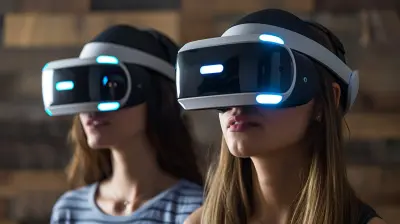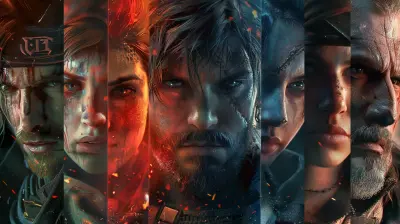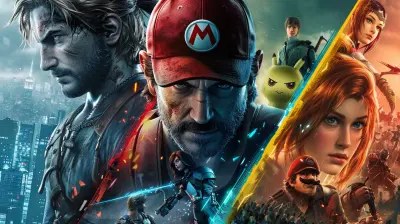Retro Gaming: The Return of Pixel Art Masterpieces
10 November 2025
If you’ve been noticing a huge resurgence of pixel art games lately, you’re not alone. Retro gaming is back—and it’s cooler than ever. This isn’t just nostalgia tapping us on the shoulder; it’s a full-fledged celebration of an art style that defined an era and continues to inspire gamers and creators alike. Pixel art, once a limitation of early gaming technology, has now become a deliberate aesthetic choice. Why? Let’s dive in, shall we?![]()
The Nostalgia Factor: Why Retro Gaming Feels So Good
Let’s be honest: we all love a good dose of nostalgia. There’s just something magical about booting up an 8-bit or 16-bit game. The chiptune music starts playing, the familiar blocky graphics fill the screen, and suddenly you’re back on the living room floor with a controller in hand, completely immersed.Nostalgia is a powerful thing. It’s comforting. It brings back memories of simpler times when all we cared about was finishing a level or beating a boss. But retro gaming goes beyond just reminiscing. For many, it’s like opening a time capsule and rediscovering the roots of gaming—before microtransactions and massive open worlds dominated the scene.
The Science of Nostalgia
Did you know that research shows nostalgia can boost mood and even make us feel more connected? Games like "Super Mario Bros." or "The Legend of Zelda" bring back not just memories of the game, but also the context around them—maybe a weekend playing with siblings or the thrill of finally saving your allowance to buy your favorite title. Gaming wasn’t just an activity; it was an experience that stuck with us.Pixel Art: From Limitation to Liberation
Back in the ‘80s and ‘90s, pixel art wasn’t a stylistic choice; it was a necessity. Console hardware and graphical capabilities were incredibly limited, so developers had to get creative. Every single pixel mattered. Entire worlds, characters, and stories were built with just a handful of brightly colored squares.But here’s the thing—what was once considered a limitation has become a style all its own. Today’s indie developers are proving that pixel art is timeless. It doesn’t matter if you’ve got access to 4K resolution or photorealistic graphics; there’s something uniquely captivating about pixel art that no other medium can replicate.
What Makes Pixel Art So Special?
Pixel art is the “less is more” philosophy in action. It’s proof that beauty doesn’t need to be complicated. With just a few pixels, you can create something iconic. Look at characters like Mario, Sonic, or Mega Man. They’re simple yet instantly recognizable—an incredible feat of design.Pixel art also sparks the imagination. Because the visuals aren’t hyper-realistic, your brain has room to fill in the details. It’s a little like reading a book, where you envision the scenes in your mind. Retro games leave just enough to the imagination, letting each player connect with the game in their own way.![]()
Indie Games: Keeping the Pixel Art Spirit Alive
If you ask me, indie developers deserve a standing ovation for keeping pixel art alive. While triple-A studios often chase hyper-realism and massive budgets, indie devs are out here doing their own thing—and absolutely crushing it.Games like Stardew Valley, Celeste, and Hollow Knight have shown that pixel art is still very much alive and kicking. These modern masterpieces blend retro visuals with contemporary gameplay mechanics, creating experiences that feel fresh yet familiar.
The Role of Pixel Art in Indie Culture
Why do so many indie developers gravitate toward pixel art? For one, it’s cost-effective. Creating pixel art doesn’t require the massive teams or sky-high budgets that 3D modeling and animation often demand. But it’s not just about the money. Pixel art also comes with a built-in charm and authenticity that resonates with players.Indie devs excel at storytelling, and pixel art seems to go hand-in-hand with that. Whether it’s the emotional journey of Celeste or the laid-back farming of Stardew Valley, there’s something about pixel art that makes these games feel more intimate. It’s like sitting down to watch a heartfelt indie film rather than a Hollywood blockbuster.![]()
The Evolution of Retro Gaming: Old Meets New
What’s really cool about the return of pixel art is how developers are blending old-school aesthetics with modern innovations. We now have games that look retro but play like nothing we’ve ever experienced before.Take Octopath Traveler as an example. It uses what’s been dubbed "HD-2D" graphics, combining traditional pixel art with advanced lighting, textures, and depth-of-field effects. The result? A visual style that feels both nostalgic and cutting-edge.
Similarly, roguelikes like Dead Cells and Hades take the gameplay complexity of modern design and merge it with the charm of pixel-perfect visuals. It’s the best of both worlds—a mash-up of the past and the present.
The Community Behind the Craze
Let’s not forget the incredible retro gaming community that’s driving this pixel art renaissance. From YouTubers and Twitch streamers to Reddit threads and online forums, gamers are passionately keeping the classics alive. And it’s not just about playing old games—it’s about celebrating them.Between speedrunning events like Games Done Quick and retro-inspired fan art popping up all over the internet, it’s clear that this isn’t just a passing trend. Pixel art has become a cultural phenomenon, and it’s here to stay.
Fan-Made Creations and Mods
Ever heard of ROM hacks or fan remakes? The retro gaming community is filled with creators who pour hours into modifying or reimagining classic games. Whether it’s adding new levels to Super Mario World or entirely reinterpreting The Legend of Zelda, these projects are proof of just how much love gamers have for pixel art and retro titles.Why Retro Gaming Still Matters Today
So, why does retro gaming—and specifically pixel art—still hold such a special place in our hearts? It’s because it’s more than just graphics. It’s about creativity, storytelling, and connection. Pixel art games remind us that great design doesn’t depend on the latest technology; it depends on heart and soul.In an era where games often feel like massive productions, retro-inspired titles bring us back to the basics. They remind us why we fell in love with gaming in the first place: because it’s fun, imaginative, and downright magical.
Looking Ahead: The Future of Pixel Art Masterpieces
When it comes to pixel art, the possibilities are endless. As technology continues to advance, more and more developers will experiment with blending retro styles and modern techniques. Who knows? Maybe the next great gaming masterpiece will arrive in the form of a pixelated hero on a grand adventure.Pixel art has proven itself to be more than just a relic of the past—it’s a versatile, enduring art form that keeps evolving. So, don’t be surprised if we’re still celebrating these pixel-perfect creations for decades to come.
Final Thoughts
Retro gaming and pixel art are so much more than a trend—they’re a movement. Whether you grew up playing these games or you’re discovering them for the first time, there’s something undeniably special about diving into a pixelated world. So, grab a controller, fire up your favorite retro-inspired game, and get ready to experience the magic. After all, who says you can’t go back in time?all images in this post were generated using AI tools
Category:
Gaming HistoryAuthor:

Brianna Reyes
Discussion
rate this article
1 comments
Blaine Coleman
What a fantastic exploration of retro gaming! Pixel art truly captures the charm and nostalgia of classic games. It’s heartwarming to see these masterpieces making a comeback, reminding us of the creativity and passion that defined an era. Keep up the great work!
November 11, 2025 at 4:35 AM

Brianna Reyes
Thank you! I'm glad you enjoyed the article and appreciate the charm of pixel art. It's exciting to see its resurgence in modern gaming!


